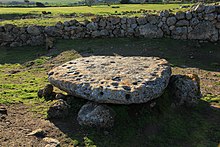
Back قرابين حيوانية Arabic Животинско жертвоприношение Bulgarian পশু উৎসর্গ Bengali/Bangla Sacrifici d'animals Catalan Tieropfer German Θυσία ζώων Greek Bestofero Esperanto Sacrificio de animales Spanish قربانی کردن حیوان Persian पशुबलि Hindi

Animal sacrifice is the ritual killing and offering of one or more animals, usually as part of a religious ritual or to appease or maintain favour with a deity. Animal sacrifices were common throughout Europe and the Ancient Near East until the spread of Christianity in Late Antiquity, and continue in some cultures or religions today. Human sacrifice, where it existed, was always much rarer.
All or only part of a sacrificial animal may be offered; some cultures, like the ancient and modern Greeks, eat most of the edible parts of the sacrifice in a feast, and burnt the rest as an offering. Others burnt the whole animal offering, called a holocaust. Usually, the best animal or best share of the animal is the one presented for offering.
Animal sacrifice should generally be distinguished from the religiously prescribed methods of ritual slaughter of animals for normal consumption as food.

During the Neolithic Revolution, early humans began to move from hunter-gatherer cultures toward agriculture, leading to the spread of animal domestication. In a theory presented in Homo Necans, mythologist Walter Burkert suggests that the ritual sacrifice of livestock may have developed as a continuation of ancient hunting rituals, as livestock replaced wild game in the food supply.[1]
- ^ Homo Necans: The Anthropology of Ancient Greek Sacrificial Ritual and Myth. trans. Peter Bing. Berkeley: University of California. 1983. ISBN 0-520-05875-5.
{{cite book}}: CS1 maint: others (link)
© MMXXIII Rich X Search. We shall prevail. All rights reserved. Rich X Search